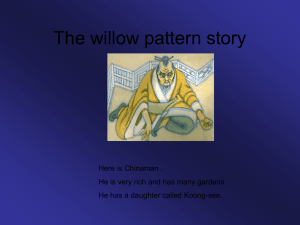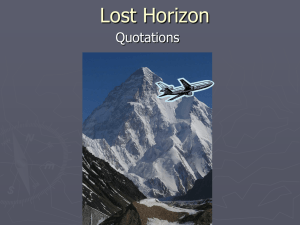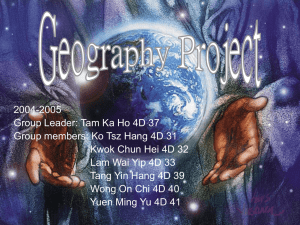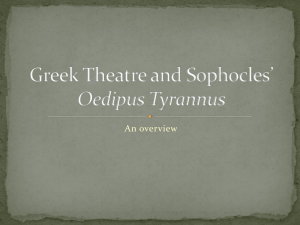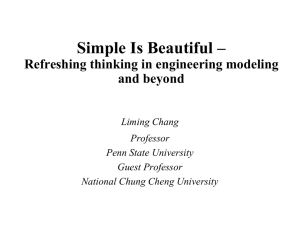pptx - Department of Computer Science
advertisement
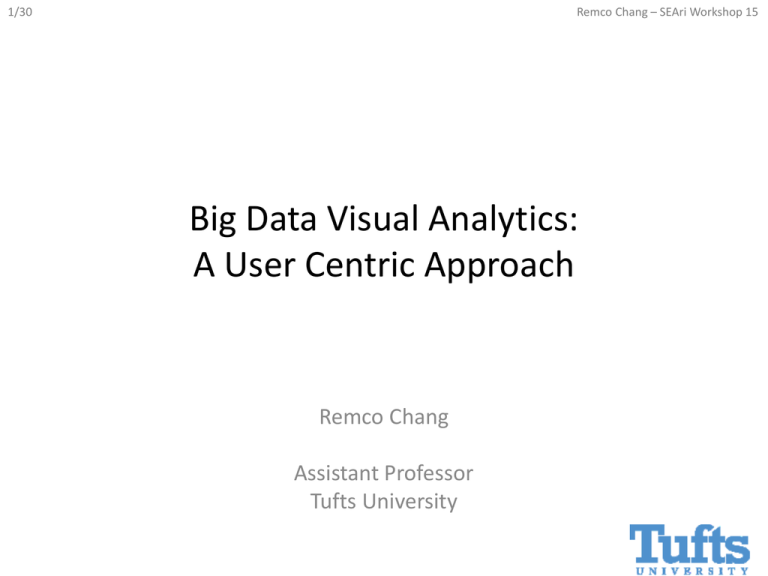
1/30
Remco Chang – SEAri Workshop 15
Big Data Visual Analytics:
A User Centric Approach
Remco Chang
Assistant Professor
Tufts University
2/30
Remco Chang – SEAri Workshop 15
Human + Computer
• Human vs. Artificial Intelligence
Garry Kasparov vs. Deep Blue (1997)
– Computer takes a “brute force” approach
without analysis
– “As for how many moves ahead a
grandmaster sees,” Kasparov concludes:
“Just one, the best one”
• Artificial vs. Augmented Intelligence
Hydra vs. Cyborgs (2005)
– Grandmaster + 1 chess program > Hydra
(equiv. of Deep Blue)
– Amateur + 3 chess programs >
Grandmaster + 1 chess program1
1. http://www.collisiondetection.net/mt/archives/2010/02/why_cyborgs_are.php
3/30
Remco Chang – SEAri Workshop 15
Example: What Does (Wire) Fraud Look Like?
• Financial Institutions like Bank of America have legal responsibilities
to report all suspicious wire transaction activities (money laundering,
supporting terrorist activities, etc)
• Data size: approximately 200,000 transactions per day (73 million
transactions per year)
• Problems:
– Automated approach can only detect known patterns
– Bad guys are smart: patterns are constantly changing
– Data is messy: lack of international standards resulting in ambiguous
data
• Current methods:
– 10 analysts monitoring and analyzing all transactions
– Using SQL queries and spreadsheet-like interfaces
– Limited time scale (2 weeks)
4/30
Remco Chang – SEAri Workshop 15
WireVis: Financial Fraud Analysis
• In collaboration with Bank of America
– Develop a visual analytical tool (WireVis)
– Visualizes 7 million transactions over 1 year
– Beta-deployed at WireWatch
• A great problem for visual analytics:
– Ill-defined problem (how does one define fraud?)
– Limited or no training data (patterns keep changing)
– Requires human judgment in the end (involves law enforcement
agencies)
• Design philosophy: “combating human intelligence requires
better (augmented) human intelligence”
R. Chang et al., Scalable and interactive visual analysis of financial wire transactions for fraud detection. Information Visualization,2008.
R. Chang et al., Wirevis: Visualization of categorical, time-varying data from financial transactions. IEEE VAST, 2007.
5/30
Remco Chang – SEAri Workshop 15
WireVis: A Visual Analytics Approach
Heatmap View
(Accounts to Keywords
Relationship)
Search by Example
(Find Similar
Accounts)
Keyword Network
(Keyword
Relationships)
Strings and Beads
(Relationships over Time)
6/30
Remco Chang – SEAri Workshop 15
Visual Analytics = Human + Computer
• Visual analytics is “the
science of analytical
reasoning facilitated by
visual interactive
1
interfaces.”
• By design, it is a
collaboration between
human and computer to
solve hard problems.
1. Thomas and Cook, “Illuminating the Path”, 2005.
7/30
Remco Chang – SEAri Workshop 15
“The computer is incredibly fast, accurate, and
stupid. Man is unbelievably slow, inaccurate,
and brilliant. The marriage of the two is a force
beyond calculation.”
-Leo Cherne, 1977
(often attributed to Albert Einstein)
8/30
Remco Chang – SEAri Workshop 15
Which Marriage?
9/30
Remco Chang – SEAri Workshop 15
Which Marriage?
10/30
Remco Chang – SEAri Workshop 15
Applications of Visual Analytics
• Political Simulation
– Agent-based analysis
– With DARPA
• Global Terrorism
Database
– With DHS
• Bridge Maintenance
– With US DOT
– Exploring inspection
reports
• Biomechanical Motion
– Interactive motion
comparison
R. Chang et al., Two Visualization Tools for Analysis of Agent-Based Simulations in Political Science. IEEE CG&A, 2012
11/30
Remco Chang – SEAri Workshop 15
Applications of Visual Analytics
• Political Simulation
– Agent-based analysis
– With DARPA
• Global Terrorism
Database
Who
Where
What
Evidence
Box
Original
Data
– With DHS
• Bridge Maintenance
– With US DOT
– Exploring inspection
reports
• Biomechanical Motion
– Interactive motion
comparison
R. Chang et al., Investigative Visual Analysis of Global Terrorism, Journal of Computer Graphics Forum, 2008.
When
12/30
Remco Chang – SEAri Workshop 15
Applications of Visual Analytics
• Political Simulation
– Agent-based analysis
– With DARPA
• Global Terrorism
Database
– With DHS
• Bridge Maintenance
– With US DOT
– Exploring inspection
reports
• Biomechanical Motion
– Interactive motion
comparison
R. Chang et al., An Interactive Visual Analytics System for Bridge Management, Journal of Computer Graphics Forum, 2010. To Appear.
13/30
Remco Chang – SEAri Workshop 15
Applications of Visual Analytics
• Political Simulation
– Agent-based analysis
– With DARPA
• Global Terrorism
Database
– With DHS
• Bridge Maintenance
– With US DOT
– Exploring inspection
reports
• Biomechanical Motion
– Interactive motion
comparison
R. Chang et al., Interactive Coordinated Multiple-View Visualization of Biomechanical Motion Data, IEEE Vis (TVCG) 2009.
14/30
Remco Chang – SEAri Workshop 15
Future of Visual Analytics
Keyboard, Mouse
Input
Visualization
Human
Output
Images (visualizations)
•
Current Approach:
– One command, one response (not quite a collaboration)
•
Assumptions:
– User’s mouse and keyboard actions with a visualization reflect a user’s reasoning process
– If the computer knows what the user’s reasoning process, it can better support (collaborate
with) the user
•
Goals:
• Can we extract a higher level information about the user through analyzing
the user’s interactions?
• How will the computer utilize such information?
15/30
Remco Chang – SEAri Workshop 15
Extracting User Model from Interactions
1. Learning about a User in Real-Time
Who is the user,
and what is she doing?
16/30
Remco Chang – SEAri Workshop 15
Experiment: Finding Waldo
• Google-Maps style interface
– Left, Right, Up, Down, Zoom In, Zoom Out, Found
17/30
Remco Chang – SEAri Workshop 15
Pilot Visualization – Completion Time
Fast completion time
Eli Brown et al., Where’s Waldo. IEEE VAST 2014.
Slow completion time
18/30
Remco Chang – SEAri Workshop 15
Post-hoc Analysis Results
Mean Split (50% Fast, 50% Slow)
Data Representation
Classification Accuracy
Method
State Space
72%
SVM
Edge Space
63%
SVM
Action Sequence
77%
Decision Tree
Mouse Event
62%
SVM
Fast vs. Slow Split (Mean+0.5σ=Fast, Mean-0.5σ=Slow)
Data Representation
Classification Accuracy
Method
State Space
96%
SVM
Edge Space
83%
SVM
Action Sequence
79%
Decision Tree
Mouse Event
79%
SVM
19/30
Remco Chang – SEAri Workshop 15
“Real-Time” Prediction
(Limited Time Observation)
State-Based
Linear SVM
Accuracy: ~70%
Interaction Sequences
N-Gram + Decision Tree
Accuracy: ~80%
20/30
Remco Chang – SEAri Workshop 15
Predicting a User’s Personality
External Locus of Control
Ottley et al., How locus of control influences compatibility with visualization style. IEEE VAST , 2011.
Ottley et al., Understanding visualization by understanding individual users. IEEE CG&A, 2012.
Internal Locus of Control
21/30
Remco Chang – SEAri Workshop 15
Predicting Users’ Personality Traits
Predicting user’s
“Extraversion”
Linear SVM
Accuracy: ~60%
• Noisy data, but can detect the users’ individual traits
“Extraversion”, “Neuroticism”, and “Locus of Control”
at ~60% accuracy by analyzing the user’s interactions
alone.
22/30
Remco Chang – SEAri Workshop 15
User-Model Adaptive Databases
2. What Can a System Do
If It Knows Something About Its User?
23/30
Remco Chang – SEAri Workshop 15
Problem Domain: Big Data Exploration
Visualization on a
Commodity Hardware
Large Data in a
Data Warehouse
24/30
Remco Chang – SEAri Workshop 15
Problem Statement
• Constraint: Data is too big to fit into the memory or
hard drive of the personal computer
– Note: Ignoring various database technologies (OLAP,
Column-Store, No-SQL, Array-Based, etc)
• Goal: Guarantee a result set to a user’s query within X
number of seconds.
– Based on HCI research, the absolute upperbound for X is
10 seconds
– Ideally, we would like to get it down to 1 second or less
• In CS talk: trading speed for accuracy, but optimize on
minimizing latency (user wait time).
25/30
Remco Chang – SEAri Workshop 15
Our Approach:
Predictive Pre-Computation and Pre-Fetching
• In collaboration with MIT and Brown
–
–
–
–
Models the user based on their past interaction histories
“Guesses” a set of the user’s possible next moves
pre-computes and pre-fetches the necessary data chunks
If the guesses are right, the user would experience no wait
time
26/30
Remco Chang – SEAri Workshop 15
Interactive Visualization System
client
middleware
Recommender
Predictive Engine
Recommender
Recommender
Cooked Tile Cache
Caching and Query
Execution
Semi-Cooked
Tile Cache
database
Server
Server
Server
27/30
Remco Chang – SEAri Workshop 15
Preliminary System and Evaluation
• Using a simple Waldolike interface
• 18 users explored the
NASA MODIS dataset
– Users were in WA
– Database in Boston
• Tasks include “find 4
areas in Europe that
have a snow coverage
index above 0.5”
• What happens if the
guesses are “wrong”?
28/30
Remco Chang – SEAri Workshop 15
Summary
29/30
Remco Chang – SEAri Workshop 15
Wrap Up: Visual Analytics Theory and Practice
• Visual analytics offers tremendous
opportunities to combine “human +
computer” as a collaborative
computational unit
• “Increasing the input bandwidth” is a
critical challenge. There is a lot of “signal”
about the user’s reasoning process and
analysis behaviors that can be extracted
from analyzing their (past) interactions.
• By modeling the user based on their past
interactions, we can design very complex
(adaptive) systems to better support the
user. The example of “big data” is just one
of many potentially rich and impactful
example.
30/30
Remco Chang – SEAri Workshop 15
Questions?
remco@cs.tufts.edu
31/30
Remco Chang – SEAri Workshop 15
Backup
32/30
Remco Chang – SEAri Workshop 15
Prediction Algorithms
• General Idea:
– Lots of “experts” who
recommends chunks of data to
pre-fetch / pre-compute
– One “manager” who listens to the
experts and chooses which
experts’ advice to follow
– Each “expert” gets more of their
recommendations accepted if
they keep guessing correctly
33/30
Remco Chang – SEAri Workshop 15
13
48
11
3
99
2
13
99
67
45
82
7
22
42
31
Iteration: 0
34/30
Remco Chang – SEAri Workshop 15
13
48
11
3
99
2
13
99
67
45
82
7
22
42
31
Iteration: 0
35/30
Remco Chang – SEAri Workshop 15
13
48
11
3
99
2
13
99
67
45
82
7
22
42
31
Iteration: 0
User Requests Data Block 13
36/30
Remco Chang – SEAri Workshop 15
13
48
11
3
99
2
13
99
67
45
82
7
22
42
31
Iteration: 0
User Requests Data Block 13
37/30
Remco Chang – SEAri Workshop 15
13
48
11
3
99
2
13
99
67
45
82
7
22
42
31
Iteration: 0
User Requests Data Block 13
38/30
Remco Chang – SEAri Workshop 15
4
12
34
88
27
5
23
1
92
34
42
12
31
32
13
Iteration: 1
39/30
Remco Chang – SEAri Workshop 15
Training
• Instead of training the manager in real-time, this
process can be done offline
– Using past user interaction logs
• This approach is similar to how Database are
currently tuned
– Instead of a DBA manually tune the performance of a
database
– Past SQL logs are used to automatically tune the
database for an organization’s specific needs (e.g.
read-mostly, write-often, etc.)
40/30
Remco Chang – SEAri Workshop 15
How to Determine the “Experts”?
• More detail on this later
• Some obvious ones include:
–
–
–
–
Momentum-based
Data similarity-based
Frequency (hot-spot)-based
Past action sequence-based
• Generally speaking, given the “manager”
approach, we want as many different types of
“experts” as possible
41/30
Remco Chang – SEAri Workshop 15
Preliminary Results
• Using a simple Googlemaps like interface
• 18 users explored the
NASA MODIS dataset
• Tasks include “find 4
areas in Europe that
have a snow coverage
index above 0.5”
42/30
Remco Chang – SEAri Workshop 15
Worst Case Scenario: Cache Miss
13
48
11
3
99
2
13
99
67
45
82
7
22
42
31
User’s Requests Data Block 52
43/30
Remco Chang – SEAri Workshop 15
Cache Miss
• How to guarantee response time when there’s a
cache miss?
• Trick: the ‘EXPLAIN’ command
• Usage:
explain select * from myTable;
• Not standard SQL, but implemented in most
commercial databases
44/30
Remco Chang – SEAri Workshop 15
Example EXPLAIN Output from SciDB
• Example SciDB the output of (a query similar to)
Explain SELECT * FROM earthquake
[("[pPlan]:
schema earthquake
<datetime:datetime NULL DEFAULT null,
magnitude:double NULL DEFAULT null,
latitude:double NULL DEFAULT null,
longitude:double NULL DEFAULT null>
[x=1:6381,6381,0,y=1:6543,6543,0]
bound start {1, 1} end {6381, 6543}
density 1 cells 41750883 chunks 1
est_bytes 7.97442e+09
")]
The four attributes in the table
‘earthquake’
Notes that the dimensions of this
array (table) is 6381x6543
This query will touch data
elements from (1, 1) to (6381,
6543), totaling 41,750,833 cells
Estimated size of the returned
data is 7.97442e+09 bytes
(~8GB)
45/30
Remco Chang – SEAri Workshop 15
Other Examples
• Oracle 11g Release 1 (11.1)
46/30
Remco Chang – SEAri Workshop 15
Other Examples
• MySQL 5.0
47/30
Remco Chang – SEAri Workshop 15
Other Examples
• PostgreSQL 7.3.4
48/30
Remco Chang – SEAri Workshop 15
Query Modification
• Based on the resulting query plan, our system
chooses one of three strategies to reduce
results from the query
– Can be based on the literal resolution of the
visualization (number of pixels)
– Or desired data size
49/30
Remco Chang – SEAri Workshop 15
Reduction Strategies
• Aggregation:
– In SciDB, this operation is carried out as
regrid (scale_factorX, scale_factorY)
• Sampling
– In SciDB, uniform sampling is carried out as
bernoulli (query, percentage, randseed)
• Filtering
– Currently, the filtering criteria is user specified
where (clause)
50/30
Remco Chang – SEAri Workshop 15
Quick Summary
• Key Components:
1. Pre-computation and
pre-fetching
2. Three-tiered system
3. Pre-fetching based on
“expert-manager”
approach
4. Use the “explain” trick
to handle cache-miss
5. Guarantees response
time, but not data
quality
51/30
Remco Chang – SEAri Workshop 15
Future Work: Streaming
• Integrate Streaming [Fisher et al. CHI 2012]
t = 1 second
t = 5 minute
Fisher et al. , Trust Me, I'm Partially Right: Incremental Visualization Lets Analysts Explore Large Datasets Faster. CHI 2012
52/30
Remco Chang – SEAri Workshop 15
Designing “Experts”
• How much can a user’s past interactions tell us
about:
–
–
–
–
The user’s future analysis behaviors?
The user’s analysis style?
The user’s analysis intent?
The user’s mental model of the data and problem?
• Fundamental question in Visualization and HCI…
53/30
Remco Chang – SEAri Workshop 15
Project Outline
“Reverse engineer” the human
cognitive black box (by
analyzing user interactions)
A. Data Modeling
–
Interactive Metric Learning
B. User Modeling
–
Predict Analysis Behavior
C. Interactive Big Data Databases
–
Adaptive Pre-fetching and computation
R. Chang et al., Science of Interaction, Information Visualization, 2009.
54/30
Remco Chang – SEAri Workshop 15
Data Modeling
1. Interactive Metric Learning
Quantifying a User’s Knowledge about Data
55/30
1. Richard Heuer. Psychology of Intelligence Analysis, 1999. (pp 53-57)
Remco Chang – SEAri Workshop 15
56/30
Remco Chang – SEAri Workshop 15
Exploring High-Dimensional Space: iPCA
Jeong et al., iPCA: An Interactive System for PCA-based Visual Analytics. Eurovis 2009.
57/30
Remco Chang – SEAri Workshop 15
Metric Learning
• Finding the weights to a linear distance
function
• Instead of a user manually give the weights,
can we learn them implicitly through their
interactions?
58/30
Remco Chang – SEAri Workshop 15
Metric Learning
• In a projection space (e.g.,
MDS), the user directly
moves points on the 2D
plane that don’t “look
right”…
• Until the expert is happy
(or the visualization can
not be improved further)
• The system learns the
weights (importance) of
each of the original k
dimensions
• Short Video (play)
59/30
Remco Chang – SEAri Workshop 15
Dis-Function
Optimization:
Brown et al., Find Distance Function, Hide Model Inference. IEEE VAST Poster 2011
Brown et al., Dis-function: Learning Distance Functions Interactively. IEEE VAST 2012.
60/30
Remco Chang – SEAri Workshop 15
Results
• Used the “Wine” dataset
(13 dimensions, 3 clusters)
• Added 10 extra
dimensions, and filled
them with random values
• Blue: original data
dimension
• Red: randomly added
dimensions
• X-axis: dimension number
• Y-axis: final weights of the
distance function
